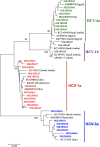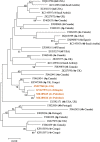Subgenotyping and genetic variability of hepatitis C virus in Palestine
- PMID: 31589628
- PMCID: PMC6779298
- DOI: 10.1371/journal.pone.0222799
Subgenotyping and genetic variability of hepatitis C virus in Palestine
Abstract
Hepatitis C virus (HCV) is a major cause of liver cirrhosis and hepatocellular carcinoma. Genotyping of HCV is crucial for successful therapy. To determine the HCV subgenotypes circulating in Palestine and to study the genetic variability of their core, we collected 84 serum samples which had tested positive for anti-HCV antibodies. Thirty-seven of these samples came from hemodialysis patients. Serum samples were subjected to viral RNA isolation and amplification of the HCV core gene. Thirty-three of the samples (39%) tested positive for HCV RNA. The HCV subgenotypes circulating in Palestine included 1a, 3a, and 4a, detected in 38%, 25%, and 22% of the samples, respectively. Furthermore, subgenotype 1b was present in three samples (9%), while the rare subgenotype 4v was present in two samples (6%). We identified a number of substitutions in the retrieved HCV core sequences, such as HCV 1b substitutions R70Q and M91L, which some studies have associated with hepatocellular carcinoma risk and poor virological response. In contrast to two previous studies reporting that HCV genotype 4 was predominant in the Gaza strip (present in just over 70% of samples), genotype 4 was detected in only 31% of the samples in our current study, whereas genotype 1 and 3 were present in 69% of samples. These differences may relate to the fact that many of our samples came from the West Bank and East Jerusalem. The co-circulation of different HCV genotypes and subgenotypes in Palestine suggests that subgenotyping prior to treatment is crucial in Palestinian patients.
Conflict of interest statement
The authors have declared that no competing interests exist.
Figures




Similar articles
-
Presence of different hepatitis C virus genotypes in plasma and peripheral blood mononuclear cell samples of Iranian patients with HIV infection.J Med Virol. 2018 Aug;90(8):1343-1351. doi: 10.1002/jmv.24925. Epub 2018 Apr 23. J Med Virol. 2018. PMID: 28845894
-
Epidemiological distribution and genotype characterization of hepatitis C virus and HIV co-infection in Wuhan, China, where the prevalence of HIV is low.J Med Virol. 2013 Oct;85(10):1712-23. doi: 10.1002/jmv.23650. Epub 2013 Jul 19. J Med Virol. 2013. PMID: 23868809
-
Most common genotypes and risk factors for HCV in Gaza strip: a cross sectional study.Virol J. 2009 Jul 16;6:105. doi: 10.1186/1743-422X-6-105. Virol J. 2009. PMID: 19607718 Free PMC article.
-
Hepatitis C virus type 1b (II) infection in France and Italy. Collaborative Study Group.Ann Intern Med. 1995 Feb 1;122(3):161-8. doi: 10.7326/0003-4819-122-3-199502010-00001. Ann Intern Med. 1995. PMID: 7810932
-
Analysis of hepatitis C virus core encoding sequences in chronically infected patients reveals mutability, predominance, genetic history and potential impact on therapy of Cuban genotype 1b isolates.Eur Rev Med Pharmacol Sci. 2011 Nov;15(11):1320-7. Eur Rev Med Pharmacol Sci. 2011. PMID: 22195367
Cited by
-
An update on hepatitis C virus genotype distribution in Jordan: a 12-year retrospective study from a tertiary care teaching hospital in Amman.BMC Infect Dis. 2019 Dec 31;20(1):3. doi: 10.1186/s12879-019-4735-3. BMC Infect Dis. 2019. PMID: 31892307 Free PMC article.
References
-
- WHO. Global hepatitis report, 2017 [WHO Report]. 2017. Available from: https://www.who.int/hepatitis/publications/global-hepatitis-report2017/en/.
-
- WHO. Guidelines for the screening care and treatment of persons with chronic hepatitis C infection 2018. Available from: https://www.who.int/hepatitis/publications/hepatitis-c-guidelines-2018/en/. - PubMed
-
- AASLD-IDSA. HCV Guidance: Recommendations forTesting, Managing, and Treating Hepatitis C:; 2018 [updated May 24. 2018; cited 2019]. Available from: https://www.hcvguidelines.org/sites/default/files/full-guidance-pdf/HCVG....
MeSH terms
Substances
LinkOut - more resources
Full Text Sources

